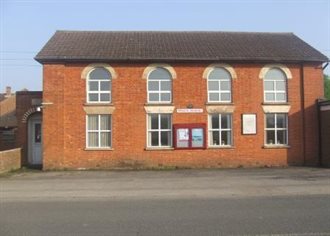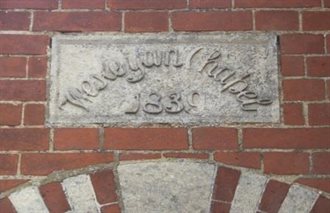Cranfield Methodist Church
This page was written by Sally Williams
Much of this summary of the Methodist faith in Cranfield is taken from the Rise of Methodism: a Study of Bedfordshire 1736-1851 by Jonathan Rodell and published in 2013 by the British Historical Records Society Volume 92, publishers The Boydell Press. The reference to Methodism encompasses both the Wesleyan Methodist and the Primitive Methodist communities.

Cranfield Methodist Chapel, High Street [Photograph by Sally Williams]
From 1763, John Wesley made Bedford a permanent base for his itinerant preachers in this area and by 1769, Cranfield was included in this circuit. On 27 October 1769 John Wesley preached to a “serious congregation” in Cranfield. Thereafter, the fortunes of the faith in Cranfield seem to mirror the national picture of waxing and waning.
By 1781, when the Circuit Book commences, Cranfield along with a number of other societies including Millbrook and Woburn was missing from the list. There was a general decline in support for Methodism in the 1770s.
At the start of the nineteenth century circuits in this part of the country were reorganised into smaller and more compact circuits and with the engagement of professional preachers, there seems to have been a revival in support.
In 1804 a cottage was licensed for preaching in Cranfield but by the 1840s Wesleyan support had declined again. At Cranfield, Salford and Aspley Guise, the combined membership fell from 118 in 1841 to 45 in 1851. In Cranfield in 1839 there had been a congregation of 150 but by 1851 the best attended service attracted only 60 worshippers.
Despite this however, The Religious Census of 1851 shows there was still considerable support for Methodism. Across the county of Bedfordshire, the Methodists were recorded as having 142 places of worship (including the Primitive Methodists and other smaller denominations) and 27,612 persons listed as attending Methodist places of worship. This represented 22% of the total county population. (By comparison the Church of England had 137 places of worship and an estimated 36,832 followers representing 29% of the total population).
At this time they were 130 Methodist congregations with 65 Sunday schools. The Census shows that Cranfield had a Primitive Methodist Society alongside the pre-existing Wesleyan Society, although it appears that only the Wesleyan congregation ever had its own chapel, which was built in 1839.

Date stone over doorway [Photograph by Sally Williams]
Historians point out that the figures from the 1851 Census should be treated with some caution as some returns were incomplete and others missed off altogether. Nevertheless it gives an overall indication of the situation at the time.
In 1890 the Wesleyan Chapel Committee granted permission for the enlargement of the chapel at Cranfield by the building of a schoolroom [MB2/CRA/6/2086]
In 1971 a service was held to celebrate the reopening and rededication of the Church after it was redesigned and extended. Further renovation work was carried out in the mid-1990s [MB2/CRA/5/3583, MB2/CRA/6/3596-7].
Cranfield Methodist closed and worship there ceased in the autumn of 2022. The chapel at High Street, Cranfield was sold in June 2023.
Records held by Bedfordshire Archives include:
- MB2/CRA/2/2085: Trustees minute book, 1903-1950;
- MB2/CRA/2/3554: Leaders meeting minutes, 1969-1992;
- MB2/CRA/8/1853/2: Minute book of the Christian Endeavour Society, 1942-1963;
- MB2/CRA/6/3587: Church Property Committee minute book, 1978-1996
- MB2/CRA/7/1839-1840: Sunday School teachers’ meeting minute book, 1904-1948;
- MB2/CRA/7/16/3610-3616: Pulpit notice books, 1963-1977;
- MB2/CRA/7/16/4705-4709: Pulpit notice books, 1977-1989